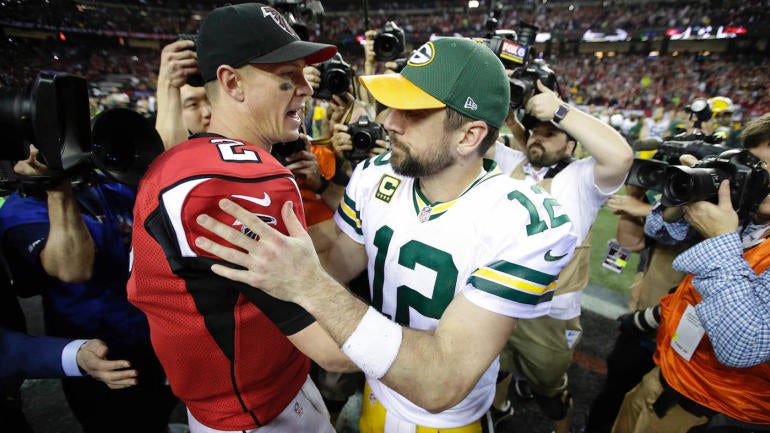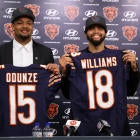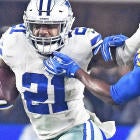
The Green Bay Packers put their 3-0 record on the line Monday night, when they host the 0-3 Atlanta Falcons. These are two teams that clearly look to be moving in opposite directions, with the Packers staving off the regression that seemed to be coming their way after a 13-3 season that was not supported by their lackluster point differential and the Falcons blowing big second-half leads left and right.
Aaron Rodgers is throwing lasers all over the field, and he should have a field day against an Atlanta secondary that has been torn to shreds by Russell Wilson, Dak Prescott, and even Nick Foles. Matt Ryan has a plethora of targets to throw to as well, and the Green Bay pass defense has been surprisingly soft, so this game could get into shootout territory. Let's break things down.
How to watch
Date: Monday, Oct. 5 | Time: 8:50 p.m. ET
Location: Lambeau Field (Green Bay, Wisconsin)
TV: ESPN | Stream: fuboTV (try for free)
Follow: CBS Sports App
When the Falcons have the ball
Don't blame Atlanta's offense for the team's 0-3 record. (Well, give it some of the blame. Just give more to the defense.) The Falcons average 30 points and 419 yards per game despite Julio Jones playing injured in the first two contests and not playing at all in the third, and despite Todd Gurley running like he's stuck in the same mud he was last year, in a season that fell so short of expectations that the Rams cut him and were willing to take a monster dead-money hit on their books because of it.
Calvin Ridley has emerged as a bona fide No. 1 receiver in his own right, absolutely smoking the Seattle, Dallas, and Chicago secondaries for a 21-349-4 line in three games, going over 100 each time. Russell Gage has acquitted himself well in the slot. Hayden Hurst hasn't contributed much outside of his big game against the Cowboys, but that could change tonight because Green Bay ranks only 27th in Football Outsiders' DVOA on passes to tight ends. (Julio may or may not play in this one, but if he's in, he should be able to get open. He does against everybody.)
Why the Falcons seem so intent on feeding the ball to Gurley when he's struggling as badly as he is (and when Brian Hill has looked much more explosive) is a bit puzzling. The Falcons have run the ball 51 percent of the time on first and second downs in neutral situations, a rate that is actually higher than the league average of 48 percent, per Sharp Football Stats. The Falcons' success rate on those runs is also below average, so it's not like things are working out particularly well for them with that strategy.
The Green Bay defense has been unsurprisingly soft against the run this season (27th in DVOA), but surprisingly friendly against the pass (20th) as well. Jaire Alexander (74.4 passer rating allowed, per Pro Football Focus) and Chandon Sullivan (69.1) are playing well on the back end, but Kevin King (123.7), safeties Will Redmond (145.8), Adrian Amos (152.1), and Darnell Savage (158.3), and linebacker Christian Kirksey (129.2, also now injured) have been easy to pick on.
The question for Atlanta is largely whether the offensive line will be able to hold up long enough to give Matt Ryan time to find open receivers down the field, and whether the Falcons will try to pick on the right guys. Among Atlanta's offensive line starters, only Jake Matthews is playing particularly well in the pass game, and guard Chris Lindstrom has been a flat-out liability, allowing nine pressures in three games. Ryan has been getting rid of the ball pretty quickly and so hasn't been under pressure all that often, but that could change against Za'Darius Smith, Preston Smith, and Rashan Gary, who are off to somewhat slow starts but also ready to take advantage of any leaks in protection.
If Atlanta can get Ridley open downfield, Hurst open over the middle, and use the pass to set up the run rather than the other way around, the Falcons should be able to see some degree of offensive success in this one. If they try to force-feed Gurley or throw at Alexander rather than one of the other, more vulnerable corners, things could get considerably tougher for them.
When the Packers have the ball
All offseason, there were legitimate questions and concerns about the Green Bay offense. Why was their only addition to the pass-catcher corps Devin Funchess, who later opted out of the season? Why did they draft a backup quarterback in the first round, a third-string running back in the second round, and a blocking tight end in the third? Were they really planning on taking the ball out of Aaron Rodgers' hands and turning this offense into a facsimile of last year's 49ers?
Through three weeks, everything looks just fine. Green Bay is first in scoring, second in yards per game, and second in Football Outsiders' offensive DVOA, and one of just two teams with a top-five rushing and passing offense. Rodgers looks better than he has in years, with his best completion percentage since 2012, best yards per attempt average since 2014, highest touchdown rate since 2011, lowest sack rate ever, second-best passer rating ever, and best QBR ever. And that's despite playing a game and a half without Davante Adams. Jordan Love hasn't played, A.J. Dillon is not contributing, and Josiah Deguara has been on the field for only 24 offensive snaps ... and it just hasn't mattered.
Meanwhile, Green Bay's offense has not been nearly as run-focused as the Packers told us they wanted it to be. The team's situation-neutral pass rate of 60 percent, per Sharp Football Stats, is actually higher than the league average of 57 percent. The same is true on early downs, where their 55 percent pass rate is 3 percent higher than the 52 percent league average. It helps that Rodgers is playing within the offense and taking the throws quickly available to him, rather than consistently waiting and trying to spring a big play.
Rodgers has gotten rid of the ball in an average of 2.49 seconds this season, per Pro Football Focus, compared with an average of 2.74 last year and 2.75 in 2018. More than 50 percent of his throws have been released within 2.5 seconds of the snap (50.5, to be exact), compared with 44.2 percent in 2019 and 44.6 percent in 2018. Being willing to get the ball out and let guys do work after the catch has helped Rodgers cut down on one of the most annoying habits he developed over the past couple of years: throwing the ball away far too often. Rodgers' throwaway rate spiked to ridiculous levels in 2018 and 2019, but has dropped back down to a much more manageable one so far this year.
| Year (Reg+Post) | Throwaways | Attempts | Away % |
| 2008-17 | 235 | 5431 | 4.33% |
| 2018-19 | 105 | 1233 | 8.52% |
| 2020 | 6 | 106 | 5.66% |
This should not be a shocking thing to learn, but when you throw the ball away less often, you give yourself more chances to make a play. I know, it sounds crazy. Apparently, Rodgers has re-learned that.
What does all this mean for tonight? Well, the Falcons don't really pressure quarterbacks all that often, which means Rodgers should have plenty of time to decide where to go with the ball. The Falcons don't cover all that well, which means Rodgers' receivers should be open -- even if Adams has to sit out another game. Oh, and they're giving up 4.5 yards per carry and have also already allowed five touchdowns on the ground, which means Aaron Jones should have an opportunity to eat as well. It's really difficult to see this defense getting all that many stops.
Prediction: Packers 33, Falcons 23






















